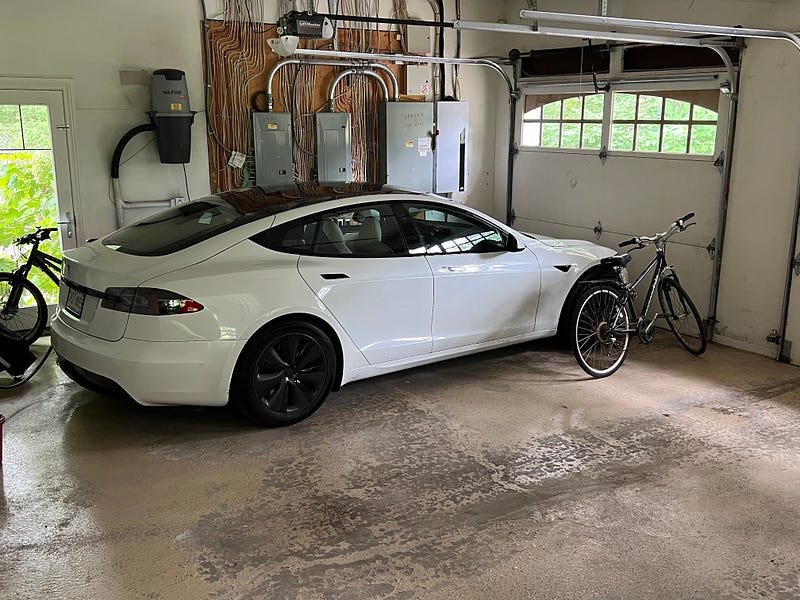A Journey from Lucid Air to Tesla: My Three-Month Experience
Written on
Chapter 1: Initial Impressions
After three months of driving a Lucid Air, I came to a surprising conclusion: while it may be a superior vehicle compared to my Tesla Model S in some respects, it ultimately wasn't the right fit for me.
“Ouch, that really hurt.” I lost a staggering 30% of the car's value—$35,000—in just three months. Yet, there was nothing wrong with the vehicle itself.
In March 2023, I purchased a Lucid Air Dream Touring Edition. Having owned a Tesla for eight years, I was eager to see if a new contender had emerged. Reviews and headlines indicated that Lucid was a formidable rival. During my visit to the showroom, I noticed that many of Tesla’s standout features were mirrored in the Lucid Dream Edition. The ability to use my iPhone as a key? Check. Autopilot? Check. Apple CarPlay? Wow, even Tesla doesn't offer that!
The car's aesthetics were stunning. As I drove it, strangers honked, and crowds gathered when I parked. I fondly remembered the excitement I felt with my first Tesla Model S back in 2012, especially when I saw the light show from the front lights upon unlocking the car.
However, as the weeks went by, the initial allure began to fade. Yes, the spacious interior was impressive. Yes, the sound system outperformed my Tesla's. Yes, it was quieter, with minimal wind noise and creaking. Yes, my wife preferred riding in the Lucid for our dinner outings.
But when it came to practicality—like loading my kids' hockey equipment—the Tesla’s hatchback design was far more user-friendly. Moreover, Tesla's Autopilot and Full Self-Driving (FSD) features are unmatched in the market. Navigating was also a breeze, thanks to Tesla’s large screen, allowing me to manage navigation, music, and car settings all at once.
Before acquiring the Lucid, I had already kept my Tesla due to the interest shown by friends in my Tesla WhatsApp group. I received several quick offers for my two-year-old Model S, giving me confidence that I could sell it whenever needed. However, during my test drive of the Lucid, the salesperson seemed remarkably uninformed about the Dream Drive Autopilot. He struggled to demonstrate it during the test drive, raising my suspicions.
When my Lucid arrived—two months ahead of schedule, which felt like a warning sign—I found out that the Dream Drive’s Highway Assist feature wasn’t available in Canada. I was assured it would be available soon, so I accepted delivery. I tend to be trusting.
Initially, I planned to alternate driving the Lucid and the Tesla, but that quickly changed. I found myself using the Tesla for daily commutes and for transporting the kids due to their sports gear, while the Lucid became my leisure vehicle for outings with friends or when I wanted to blast my music.
A couple of months later, Highway Assist became available, and I began using the Lucid for my two-hour commute into Toronto from Mississauga. It functioned adequately—most of the time. However, it would frequently shut off when approaching construction zones and was limited to major highways, unlike Tesla’s capabilities that work on any road, any time. When I wanted to change my Spotify playlists, I felt comfortable putting my Tesla on autopilot for a few moments. The Lucid didn’t afford me that luxury; if it came to a complete stop, I had to manually restart it.
Driving the Lucid gave me a sense of exclusivity, while driving the Tesla felt routine, just a means to an end.
Three months in, I realized I was hardly using the Lucid. Its impressive features and sleek design couldn't outweigh the efficiency of Tesla's autopilot, and I doubted Lucid would catch up in the near future.
When I reached out to my Lucid salesperson about my disappointment, I learned he had left the company. Not surprising, considering I had mentioned selling my Tesla, and he expressed interest in purchasing it. In hindsight, I had overlooked many warning signs.
I sold the Lucid through Carnex, an online retailer specializing in electric vehicles. They took it on consignment, as the market value of the car was uncertain, given that few others were selling Lucids. However, customers could buy new vehicles directly from Lucid and receive immediate delivery—something that was impossible with Tesla during the early years of production.
Despite the significant loss from my brief experiment, I have no regrets about trying the Lucid. If you share my wife's sentiment and are among the many Tesla owners who don't utilize autopilot, you might prefer the Lucid. If you don’t regularly transport sports gear, the Lucid is indeed a more appealing option. Overall, the Lucid Air Dream is an exquisite car with impressive software, yet it seems to attract limited interest. I had hoped to exchange experiences with a friend who was set to purchase a Lucid, but he canceled his order before delivery.
Now, I find myself back with Tesla. There’s just one feature I miss from the Lucid: Elon, if you’re listening, could you please add Apple CarPlay? I promise, I won’t consider any other EV.

Chapter 2: Thoughts on the Lucid Air Experience
In the video "Here's Why I Sold My Lucid Air!", I discuss my reasons for parting with the Lucid Air after a brief ownership experience.
In "Here's The Plan Now That I Sold My Lucid Air!", I outline my next steps and thoughts about returning to Tesla.